Several of our patterns are available in two sizes (two stitch counts, which makes the finished piece different dimensions). Many people ask, “How are they different? They look the same.”
In general, we make our patterns as small as possible (believe it or not!) while still preserving the important detail of the original work. Sometimes, though, it’s possible to make a somewhat smaller pattern which is not quite as detailed, but still very good, and a lot fewer stitches. Think about it: a 200 x 200 stitch count pattern is 40,000 stitches. 180 x 180 doesn’t sound much smaller, but it’s only 32,400 stitches. A 9% decrease in the sides (width plus height) results in a 19% decrease in the number of stitches!
So how are they different? Here are a few examples.
Take the Fair Face of Woman comes in two sizes, 197w x 250h, and 315w x 400h. On the pattern pages they look the same. If you click the pictures to see the fixed scale views, you can see that one is larger and one is smaller, but you still may not be able to see any difference.
Compare the eyes. In this case, all the same features are there, the shading in the eyelid, the lighter blue below the pupil — it’s just that they are larger in the larger version.
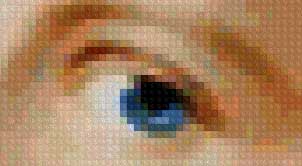
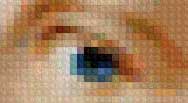
An area where a bit of detail is lost is in the beaded bag. Most of the beads are there in both bags — but the one that the fairy’s finger points to is mostly missing in the smaller bag. (It helps to get back from the screen a few feet to see this.) The beads in the larger bag also have a little structure (darker spots in the center of the beads) which is missing from the smaller bag.
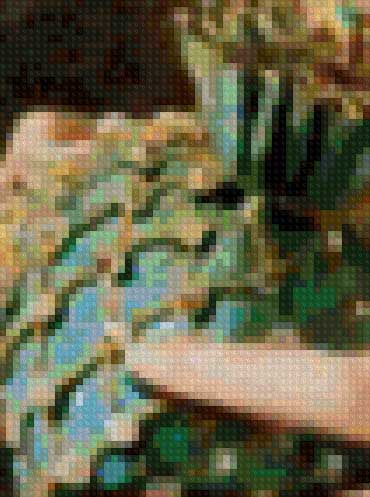
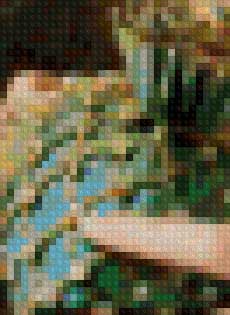
As you can see, these are not very momentous differences.
We are also working toward having all of the Lady and Unicorn tapestries in two sizes. Here the differences are quite subtle (given that the original tapestries are so large, many of the details such as the flowers are rather impressionistic even in our larger pattern). Compare two dogs from Lady with Unicorn: A Mon Seul Desir (this is the dog near the upper right corner).

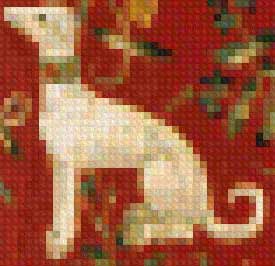
The biggest difference in the two dogs is that the smaller dog’s ear nearly disappears. The smaller dog is a little blockier, too, as there’s less room for shading stitches to fill in the curves. The flowers are almost the same. Consider, though, that there’s a 15% difference between the two charts in width plus height, and the smaller one has 30% fewer stitches!
So: if you prefer a smaller finished piece, or just want to do fewer stitches, you shouldn’t hesitate to do the smaller version of any of our charts. If you really love the picture and want all possible detail, or prefer a larger result, do the larger one. Either way, you’ll get good detail.


From Rifestitch
long agoWell, from my experience on the smaller Sense of Hearing, if I’m missing any detail, I can’t see it 🙂 I like the smaller sizes – I’ll finish them sooner than the big ones, and when framed/finished, easier to find a suitable place to display them 🙂
From Deborah LaGana
long agoIt doesn’t matter to me which one I buy, I copy and enlarge the pattern in order to mark my stitch’s as I sew, that way I do not lose my place if I have to put it down for long periods of time. I do not make copys for friends, nor do I sell them, that is not my business and I have no right to sell them. Besides I feel that if someone wants the pattern they should buy it just as I did.
You are welcome to make a markup copy of Scarlet Quince charts, and I appreciate your not giving copies away (which many people don’t realize is a violation of copyright law). However, I was really talking about two different patterns based on the same picture, not the print size.
From Alanna
long agoVery interesting to know Meredith (I love your ramblings and anything to do with the inside world of Scarlet Quince pattern making!). Here’s a curve ball for you – ever thought of doing EXTRA-LARGE versions??? That’d be me for sure. The bigger the better I say. Particularly with the Lady and Unicorn patterns, given that the original tapestries cover entire walls! Just a thought for you 😉 …
I’m game, but there is a limit imposed by the widths that fabric comes in. 18-count aida for example seems to come in 51″ widths maximum, so allowing a couple of inches on a side for finishing (minimal), that gives you 846 stitches. We don’t have anything that wide but “Hunt in the Forest” is 696 stitches wide which is getting close. I have actually given thought to whether there would be a way to join a piece stitched on two pieces of fabric but haven’t had any ideas that wouldn’t involve a colossal ugly seam. Some things could work broken up into multiple panels and we did offer “Hunt in the Forest” as three panels at one point, although there wasn’t much interest in that.
From Kiwidutch
long agoI totally and completely mixed up what ” large size” meant, (with large print pattern) Now that it’s been made clear I will know to order the larger sized pattern because for me: the more detail the better.
PLEASE please please add an ” Articles/Tips” tab to your website for this and things like the Blending threads test pieces so that this important information is easily available for all who browse here, as these gems are hard to find at present and obviously even from a few replies here, it is very clear that I am not the only one who was confused by the large sized vs large print patterns. The difference between the two is (literally, pun intended) HUGE !
The floss coverage examples ARE hard to find at the moment but if you search the site (use the search box in the upper left) for “blend examples” they come right up. Of course, you have to know that there might be something to find… We are planning a tutorials section for this and other illustrations since they’re pretty scattered around. As for being confused, that’s the reason for the article … a LOT of people have asked.
Echoing Alannna’s thought, I too say that some mega detail patterns would be MOST WELCOME, there ARE more detail fanatics out there like us who have pined for years for cross stitch patterns that are truely works of Art, and even though I am a fast stitcher, I don’t mind a project that takes a while (a year or two or even three if necessary) IF there is detail enough in it to spend the time and effort on. The enjoyment of my children, and later grandchildren, great grandchildren etc who will enjoy what I stitch for generations to come make the time spent stitching it a very real labour of Love.
You are right, stitching is all about spending time with your family and valuing time spent together. My 7 year old has just started her first stitching project (sadly not a Scarlet Quince piece, but she already has her eye on several pieces that she likes, so .. maybe for her… one day LOL)
Instilling the knowledge that handstitched items take time to produce and that the the finished works have a value beyond any fiscal sum… that more than the sum of their parts, these Cross stitch pieces are treasures in their own right: to be handed down to the people I treasure, so would never make me shy of spending the time that a mega detailed piece would demand. Here’s to mega detail ! bring it on!
Thank you!
From Deanna Wells
long agoHave you considered blending colors, i.e., two strands, one of each of two colors, where it would enhance shading? I love your choice of subject material (evident from the size of my stash), but the blended colors would entice me even more.
All of our patterns use blended colors …
From Vibeke Olason
long agoI am currently trying out the smaller version of the “Fair face of a Woman” on 22 count Aida. The main difference between the smaller and the larger version is that the smaller is sligthly blurred, while the larger is a bit “crisper”.
I have noticed that the clarity of the image impoves with reduced size. Just look at the two images on the front of the pattern; the main picture and the small icon in the upper corner. What I want to find out is if the 22 count will give a sharper image than the 18 count I have used so far. It’s a bit fiddely working on the 22 count, but it’s getting easier as I go. I just hope I never will have to unpick anything, because the stiches are really tiny!
From kiwidutch
long agoJust to add to the discussion of Alanna1 post, and the subsequent reply… 840 stitches could either be the width of the piece OR the height of the piece right? .. so we could always have to the option for the piece that was 840 high and however big you want down the length of the bolt of fabric… and if the finished piece was meant to be in “portrait” format then just turn it the right way up when you are finished 🙂 What is the widest stitching fabric available? ( sorry, I don’t know: are they not all a standard width? ) Over one stitching would allow for a mega pattern because on a 28 count fabric you can get 28 stitches to the inch ( 2.5 cm) whereas over two threads you would only achieve 14 stitches in the same space. a pattern especially for Over One stitching would easily get 1500 stitches along the width of the fabric (phew) with still space for framing etc. On 32 count Over One thread that would even be higher…. Thank you again for such wonderfully detailed patterns!
A cursory check indicates that needlework fabric comes in widths of anywhere from 43″ to 59″ wide, depending on the type of fabric and the weaver. Over 1 on 28-count does work but the blends don’t work over 1 on 32-count (see the elusive floss coverage examples page). It could certainly be done — although I can’t imagine doing something like that without a scroll frame, and the scroll bars I made are “only” 41″ long because my floor stand won’t accomodate anything larger. You might have to go to a quilting frame.
From Julie T
long agoI can tell you from experience that using two strands (which you must use with SQ because of the blended needle) is VERY difficult on fabric 25 count or smaller. It just gets way too cozy in there.
From rifestitch
long agoI’m using 22ct, and let me tell you, it’s about as tight as can be. It will be amazingly detailed when I get done, many years from now, but I will definitely look into some 20ct for the next Lady & Unicorn I do.
And as for over-1 on 28ct, I do lots of over-1 on 28 & 32 both, but they all involve only 1 thread. I am doing a Heaven & Earth Design over-1 on 28ct – but they don’t use blends even on their most massive charts.